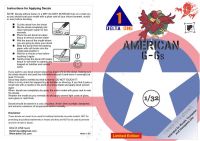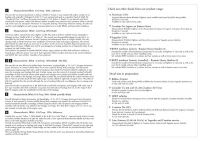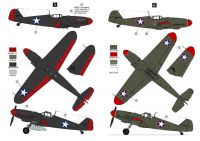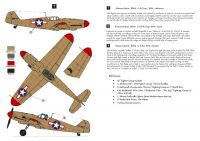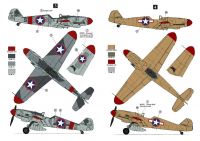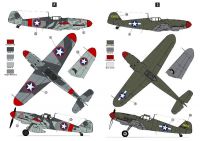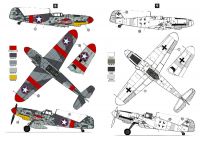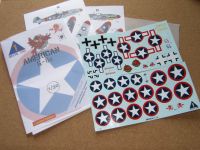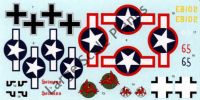Delta One | American G-6s
Reviewed by Kevin Futter
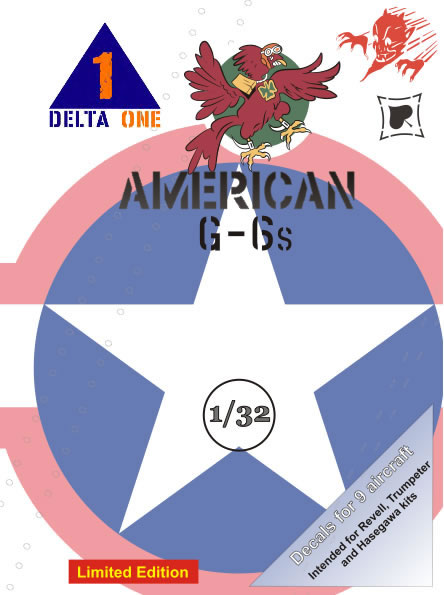
Delta One is a new decal provider out of Europe, aiming to fill gaps in the existing market. The set we're examining here is called "American G-6s", and features nine captured Bf 109G-6 aircraft in American schemes. Each scheme is accompanied by a paragraph or two of notes, and a painting guide consisting of a set of colour 3-view drawings.
Provided Schemes
The provided options are all quite interesting, varying from an olive drab over grey machine that resembles an early USAAF colour scheme, to a natural metal option complete with spurious Luftwaffe insignia. The details for each option, as provided in the instructions, are as follows:
- 1. Messerschmitt Bf109 G-6/Trop WNr. unknown
- This aircraft was found abandoned on Mateur airfield in Tunisia. It was marked with yellow number 16 on fuselage and originally it belonged to 9./JG 77. It was repaired and used as a squadron hack of 325th FG, "Checkertail Clan", and flown by group commander Lt. Col. Robert L. Baseler. It was painted matt black overall with red spinner, rudder and ailerons. USAAF roundels were painted in four positions while on the left side of the nose was inscription “Hoimann” in red gothic lettering “honouring” Hermann Göring. Aircraft was used for mock dogfights to teach young American pilots how to tackle Bf109's and boost their confidence.
- 2. Messerschmitt Bf109 G-6/Trop, WNr.16416
- American soldiers captured this intact fighter on 8th May 1943 at Soliman airfield, Tunisia. Originally it belonged to the 4. Staffel of JG 77 as “White 9”. The aircraft was dis-assembled, shipped to the U.S.A., re- assembled by the North American Aircraft Company and subsequently flown to Wright Airfield. The only changes made at North American were installation of American radio and oxygen equipment. The armour plate behind the pilot's head was removed. It was flown to the Air Forces Scientific Research Institute and logged about 29 hours of flight time until it was damaged in a landing accident on 1st September 1944. It was scrapped on 24th October 1944.
- This machine was painted in standard USAAF colours: upper surfaces in Olive drab and lower surfaces in Neutral gray while the spinner was red. It had registration EB102 in yellow lettering on the vertical stabilaser and USAAF late “star and bar” roundels in four positions.
- 3 & 4. Messerschmitt Bf109 G-6/Trop WNr.18098 (SS+WZ)
- This aircraft was just delivered to Italian Regia Aeronautica, 154 Squadriglia, 3° Gr. A.C.T. (Gruppo Autonomo Caccia Terrestre), at Comiso airfield where it was soon captured during Sicily campaign. Fred Symmank, Maintenance Engineering Chief with a staff of mechanics from 65th FS of 57th FG USAAF modified it to two- seater by removing main fuselage fuel tank. Cockpit canopy was also removed. It retained standard Luftwaffe camouflage of RLM 74/75/76 colours while spinner and wingtips were painted red. USAAF roundels with red border were added to the fuselage and wings. White number 65 was painted behind the cockpit. Number 65 in blue or red (we provide decals for both options ☺) was later added to right side of engine cover. The pilots of 57th FG regularly flew this aircraft although the use of auxiliary belly tank was obligatory due to missing main fuel tank.
- Later this aircraft was painted tan or US Dark Earth overall with red spinner and wingtips while early “star & bar” type roundels with thick red border was painted on both sides of fuselage but not on the wings! It had 65th FS insignia under the windshield on both sides of the fuselage.
- 5. Messerschmitt Bf109 G-6/Trop, WNr. 18096 possibly 18059
- Aircraft belonged to Regia Aeronautica, 154 Squadriglia, 3° Gr. A.C.T. (Gruppo Autonomo Caccia Terrestre), Comiso. It was captured at Comiso airfield during Sicily campaign and repaired by mechanics of 57th FG. It retained standard Luftwaffe camouflage of RLM 74/75/76 colours with red spinner and wingtips. USAAF roundels with red border were added to the fuselage and wings. The “Red devil” insignia of 3° Gr. A.C.T. was also retained on both sides of the engine cover.
- 6. Messerschmitt Bf109 G-6/Trop, WNr. Unknown
- Possibly this was the “Yellow 7” (WNr.18068) of the 6./JG 53 or Stab “black 4” captured in July 1943 at Comiso or Pachino airfield. Mechanics of 57th FG made this and 5 more captured Messerschmitts flyable and they were flown to the 65th Squadron Airfield at Scordia.
- Aircraft was painted Olive Drab overall with red spinner and wingtips. USAAF roundels with red border were painted on six positions on fuselage and wings. It had 65th FS insignia (”Uncle Bud”) painted on the right side of the fuselage under the cockpit. If 65th badge was later added to the left side we provided decals for both options, again. ☺
- This was probably the last flyable Messerschmitt of the 57th FG and it was destroyed at Amendola airfield prior members of the Group left it.
- 7. Messerschmitt Bf109 G-6/Trop, WNr. unknown
- This fighter was captured at Pachino airfield and repaired by mechanics of 57th FG. Aircraft was painted sand (desert yellow) colour overall with red spinner and wingtips. USAAF early “star and bar” type roundels with thick red border were painted at four positions on fuselage and wings. One photo show heavy paint peeling on the left side of fuselage behind roundel revealing darker base colour (maybe Olive Drab).
- 8. Messerschmitt Bf109 G-6/R6/Trop, WNr. 15270
- Captured at Comiso or Pachino airfield. Originally it was “Yellow 14” of the 6./JG 53 “Pik As”. It retained standard Luftwaffe camouflage (at least for some time) of RLM 74/75/76 colours with red spinner and wingtips. USAAF roundels with red border were added to the fuselage and wings. Red bands were added around the wings. 20mm MG151/20 cannon underwing pods (Rustsatz R6) were removed. It had German markings partly visible under the wings and badge of JG53 on both sides of engine cover.
- 9. Messerschmitt Bf109 G-6/R3, WNr. 160756
- This aircraft, originally “Yellow 4” of the 3./JG4, was acquired on 25th July 1944 when its pilot, Fhj.-Uffz. René Darbois defected to Americans at Santa Maria, Italy. Soon it was shipped to the USA, stripped down to bare metal of all markings and camouflage, assigned to Air Technical Intelligence Command coded FE-496 (later T2-496) and flight tested at Wright Field and Freeman Field. This aircraft was mainly displayed for bond drives and for this reason spurious German markings were applied. Even the swastika on the left side of the tail was reversed! Matt black anti-glare section was painted on the upper nose engine cowling. In 1946, aircraft went to Park Ridge and in 1948 it was transferred to the National Air and Space Museum (NASM) and subsequently to storage facility at Silver Hill, Maryland. It was restored by the Paul E. Garber Facility in 1974, and now is on display as “White 2” III./JG 27 at the NASM.
The Decals
The decals themselves are provided on two small sheets, and are very nicely printed. Colour density and registration are both very good. No printing house is given, so they appear to be an in-house production. They're traditional screen-printed decals however, and not laser, inkjet or ALPS printed.
There is almost no excess carrier film surrounding the national markings, while by contrast the smaller decals exhibit quite a bit of it. Normal decal preparation and application procedures should prevent that from being an issue, but you can always trim them more closely if you have any concerns.
On Test
Since Delta One is a previously unknown brand, and no printer is nominated anywhere in the package, I thought it might be pertinent to put these decals through their paces and apply them to a model. Predrag from Delta One had kindly sent along the 1/48 and 1/72 versions of this set (note: these are available separately, and not normally included in the 1/32 package), so I decided that a quick build of Hasegawa's venerable 1/48 Bf 109G-6 kit would provide a suitable subject.
I was fascinated by the natural metal option, so I chose scheme #9, Messerschmitt Bf109 G-6/R3, WNr. 160756 (see above for details). It took me much longer to reach the decalling stage than I had initially envisaged, which delayed this review somewhat, but the photo below shows the model with painting complete and awaiting decals:
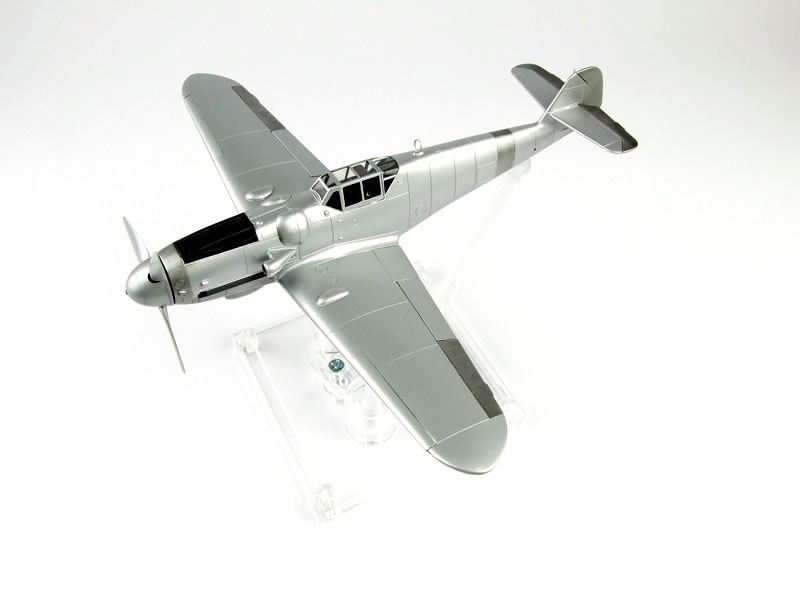
There are very few decals involved in this scheme, so the process was quick and relatively painless. The decals were soaked for a couple of minutes in tepid water, into which I had added a drop of dish-washing detergent. Each marking slid off its respective backing paper with ease, with no signs of gripping, tearing or folding. The model's surface was prepared by brushing some of the same slightly soapy water onto it; no decal setting solution was used.
Some decals like to grip a model's surface as soon as they hit it, but these from Delta One were quite happy to be moved around until the correct position was located. If anything, they could stand to be slightly more grippy, but I certainly prefer 'not quite enough' to 'too much'. Here's the model with all the decals applied:
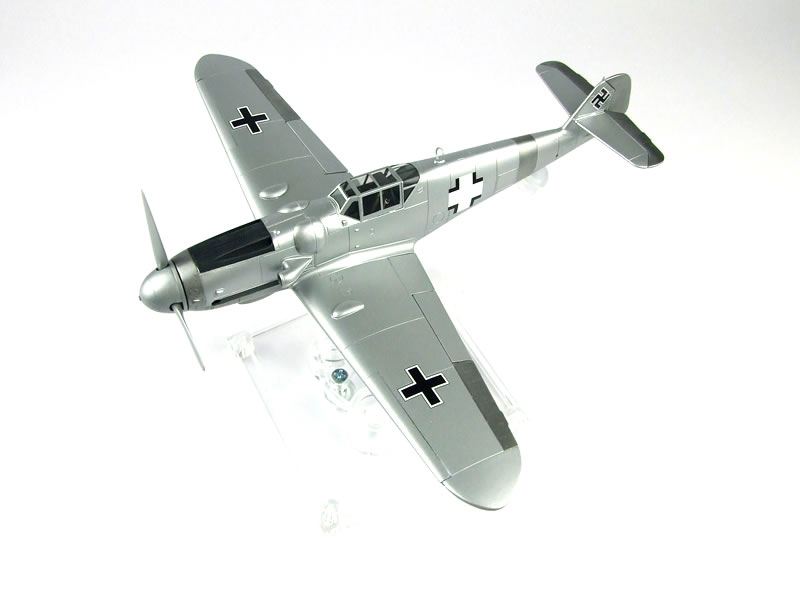
It makes for quite a striking and unusual 109! As you can see in the photo below, no carrier film is evident on the model:
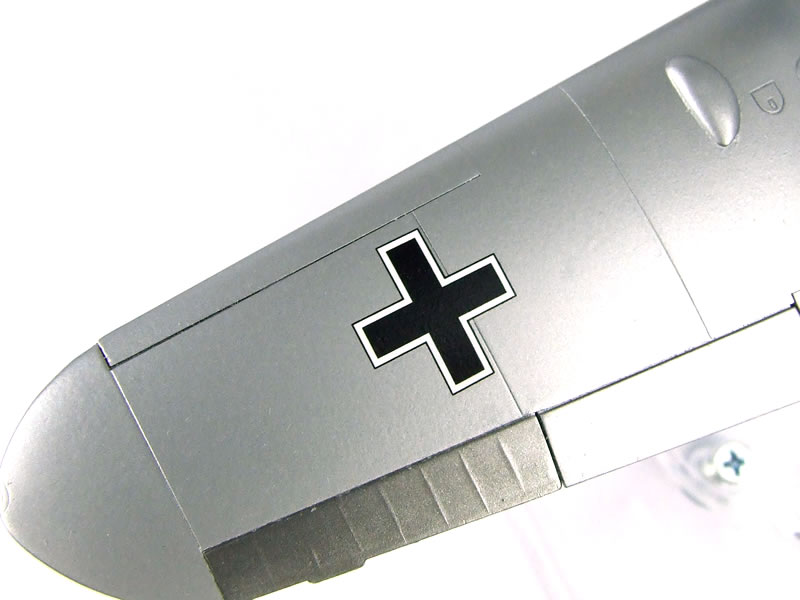
The decals were treated to a light application of Micro Sol, and the model set aside overnight. This seems to have had little impact however, as the decals didn't really settle into the panel lines to any noticeable degree:
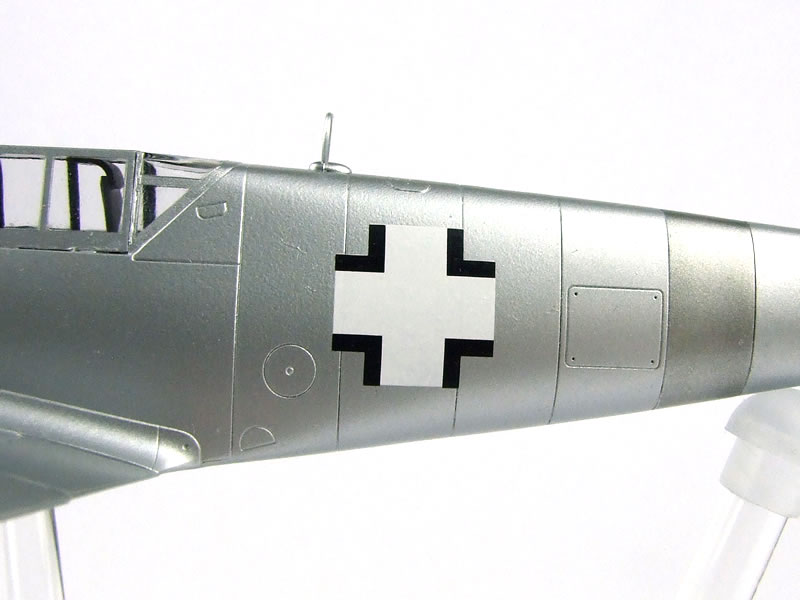
Time constraints prevented me from testing the decals with a stronger solvent, such as Mr Mark Softer, so I can't make any comments about whether such products might be more effective. My bottle of Micro Sol is also getting quite old, and has perhaps lost some of its potency.
Conclusion
With a very interesting and unusual selection of colour schemes, and a decal product that behaves well and is easy to use, I can highly recommend this set to anyone looking to produce a Bf 109 that's a little out of the ordinary.
The Delta One website had not been launched at the time of writing this review, but enquiries can be made via email at delta1decal@gmail.com.
Thanks to Delta One for the review sample.
© Kevin Futter 2014
This review was published on Wednesday, August 27 2014; Last modified on Saturday, March 26 2016

